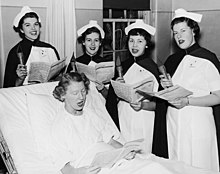
The Temerty Faculty of Medicine is the medical school of the University of Toronto. Founded in 1843, the faculty is based in Downtown Toronto and is one of Canada's oldest institutions of medical studies, being known for the discovery of insulin, stem cells and the site of the first single and double lung transplants in the world.

The Princess Margaret Cancer Centre is a scientific research centre and a teaching hospital in Toronto, Ontario, Canada, affiliated with the University of Toronto Faculty of Medicine as part of the University Health Network. The hospital now stands as the largest cancer centre in Canada and one of the five largest cancer centres in the world. Along with the Odette Cancer Centre, which is also associated with University of Toronto Faculty of Medicine and is independently the sixth largest cancer centre in North America, it forms one of the largest cluster of cancer hospitals in the world.

The Centre for Addiction and Mental Health is a psychiatric teaching hospital located in Toronto and ten community locations throughout the province of Ontario, Canada. It reports being the largest research facility in Canada for mental health and addictions. The hospital was formed in 1998 from the amalgamation of four separate institutions – the Queen Street Mental Health Centre, the Clarke Institute of Psychiatry, the Addiction Research Foundation, and the Donwood Institute. It is Canada's largest mental health teaching hospital, and the only stand-alone psychiatric emergency department in Ontario. CAMH has 90 distinct clinical services across inpatient, outpatient, day treatment, and partial hospitalization models. CAMH has been the site of major advancements in psychiatric research, including the discovery of the Dopamine receptor D2.

The Toronto General Hospital (TGH) is a major teaching hospital in Toronto, Ontario, Canada and the flagship campus of University Health Network (UHN). It is located in the Discovery District of Downtown Toronto along University Avenue's Hospital Row; it is directly north of The Hospital for Sick Children, across Gerrard Street West, and east of Princess Margaret Cancer Centre and Mount Sinai Hospital. The hospital serves as a teaching hospital for the University of Toronto Faculty of Medicine. In 2019, the hospital was ranked first for research in Canada by Research Infosource for the ninth consecutive year.

1 Spadina Crescent, also known as the Daniels Building, is an academic building that houses the John H. Daniels Faculty of Architecture, Landscape, and Design at the University of Toronto in Toronto, Ontario, Canada. The building is situated in the centre of a roundabout of Spadina Avenue, north of College Street. Its location provides a picturesque vista looking north up Spadina Avenue; it is an axial view terminus for Spadina Avenue.

The St. Lawrence Market South building is a major public market building in Toronto, Ontario, Canada. It is located on the southwest corner of Front and Lower Jarvis Streets. Along with the St. Lawrence Market North and St. Lawrence Hall, it comprises the St. Lawrence Market complex. The current building was opened in 1902, incorporating the 1845 Toronto City Hall building into the structure. The building was restored during the 1970s.
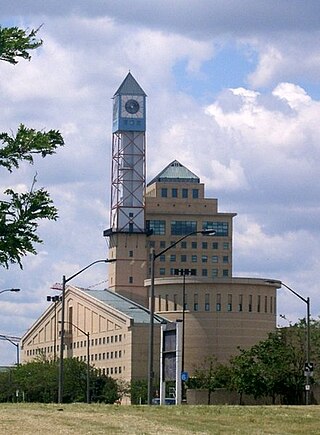
The Mississauga Civic Centre is the seat of local government of Mississauga, Ontario, Canada. The 37,280 square metre complex is a prominent example of postmodern architecture in Canada, finished in 1987 by Jones and Kirkland. It stands at 92 metres or 302 feet. The design was influenced by farmsteads which once occupied much of Mississauga as well as historical features of city centres. The building, for instance, includes a prominent clock tower. It was chosen as the winner of a design competition that included 246 submissions. Mississauga Civic Centre is located in the City Centre near Square One Shopping Centre and is home to the Mississauga City Council. The civic center building is considered one of the most iconic and recognizable buildings and cultural icons of Mississauga city.

Queen's Quay Terminal is a condominium apartment, office and retail complex in the Harbourfront neighbourhood in Toronto, Ontario, Canada. It was originally built in 1927 as a marine terminal with office, warehouse and cold-storage facilities. When shipping to Toronto declined in the 1960s and 1970s, the building was bought by the Government of Canada to be repurposed along with a section of the industrial waterfront. The Terminal Building itself was rebuilt in the 1980s with the addition of four floors of residential above the original facility, which was converted into retail and office uses. The cold storage wing was demolished and its plant building became The Power Plant gallery and Harbourfront Centre Theatre.
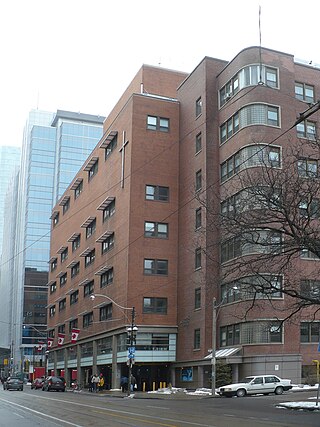
St. Michael's Hospital is a teaching hospital and medical centre in Toronto, Ontario, Canada. It was established by the Sisters of St. Joseph in 1892 with the founding goal of taking care of the sick and the poor of Toronto's inner city. The hospital provides tertiary and quaternary services in cardiovascular surgery, neurosurgery, inner city health, and therapeutic endoscopy. It is one of two Level 1 adult trauma centres in Greater Toronto, along with the larger Sunnybrook Health Sciences Centre. As trauma centres, both St. Michael's and Sunnybrook are equipped with helipads. It is one of several teaching hospitals of the University of Toronto Faculty of Medicine and is part of the Unity Health Toronto hospital network.

Toronto Rehabilitation Institute is the largest rehabilitation hospital in Canada. Owned and operated by the University Health Network (UHN), Toronto Rehab provides patients with rehabilitation care, helping people rebuild their lives and achieve individualized goals following injury and disability. It is composed of five sites across Toronto, which are: Bickle Centre, Lakeside Centre, Lyndhurst Centre, Rumsey Centre, and University Centre.
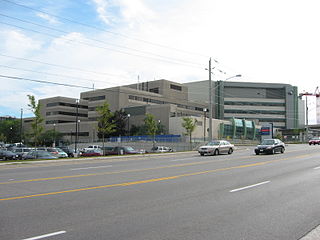
Southlake Regional Health Centre, formerly known as York County Hospital, is a hospital located in Newmarket, Ontario, Canada. Through various expansions during its history, it has grown into a university-affiliated teaching and research facility, specifically offering advanced cardiac, cancer and thoracic care.
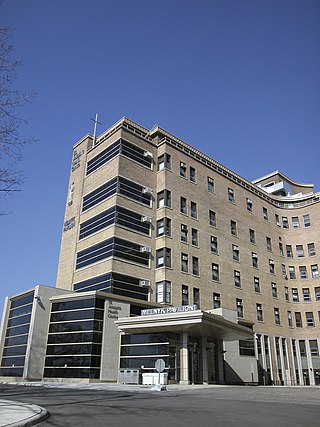
St. Joseph's Health Centre is a large teaching hospital in western Toronto, Ontario. It is located west of downtown Toronto, along the Lake Ontario shore at the intersection of The Queensway and Sunnyside Avenue, just west of Roncesvalles Avenue. It was founded in 1921 by the Sisters of St. Joseph order on the site of an orphanage. The same order also founded St. Michael's Hospital in Toronto in 1892.

The Salvation Army Toronto Grace Health Centre is a 150-bed hospital located at 650 Church Street in Toronto, Ontario. Owned and operated by the Salvation Army, it specializes in palliative care, post-acute care rehabilitation, and complex continuing care.
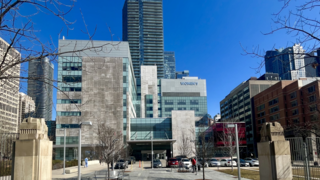
Women's College Hospital is a teaching hospital in Toronto, Ontario, Canada. It is located in downtown Toronto at the north end of Hospital Row, a section of University Avenue where several major hospitals are located. It currently functions as an independent ambulatory care hospital.
The Wellesley Hospital was a teaching hospital in Toronto, Ontario, Canada, affiliated with the University of Toronto. It was founded by Dr. Herbert Bruce as a private hospital, but became publicly operated in 1942.
MaRS Discovery District is a not-for-profit corporation founded in Toronto, Ontario, Canada in 2000. Its stated goal is to commercialize publicly funded medical research and other technologies with the help of local private enterprises and as such is a public-private partnership. As part of its mission MaRS says, "MaRS helps create successful global businesses from Canada's science, technology and social innovation." As of 2014, startup companies emerging from MaRS had created more than 4,000 jobs, and in the period of 2011 to 2014 had raised over $750 million in capital investments.

Brampton Civic Hospital is an acute care hospital in Brampton, Ontario and part of the William Osler Health System. It is a community teaching hospital for the Michael G. DeGroote School of Medicine of McMaster University.
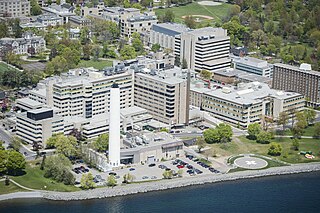
The Kingston General Hospital (KGH) site is an acute-care teaching hospital affiliated with Queen's University located in Kingston, Ontario, Canada. Along with the Hotel Dieu Hospital (HDH) site, these hospitals form Kingston Health Sciences Centre which delivers health care services to more than 500,000 residents throughout southeastern Ontario; conducts health care research and trains future health care professionals.

Richmond-Adelaide Centre is a cluster of office buildings in Toronto, Ontario, Canada, located in the financial district. It is bounded by Richmond Street West to the north, Sheppard Street to the east, Adelaide Street West to the south, and finally York Street as its western boundary. The complex is owned and operated by global real estate investor, developer and owner of Oxford Properties Group.
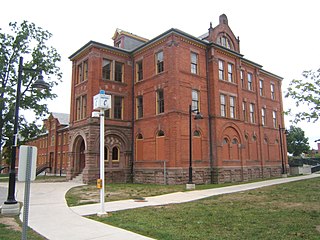
The Lakeshore Psychiatric Hospital was a psychiatric hospital located in the town of New Toronto, Ontario. The hospital grounds now form part of Humber College's Lakeshore Campus.


